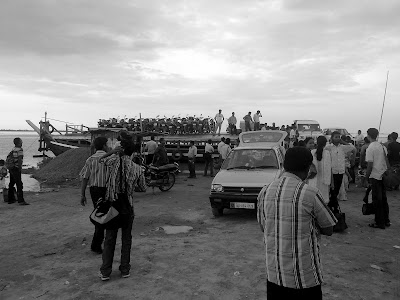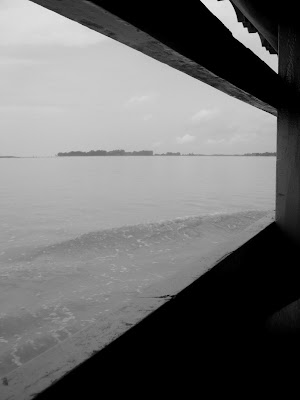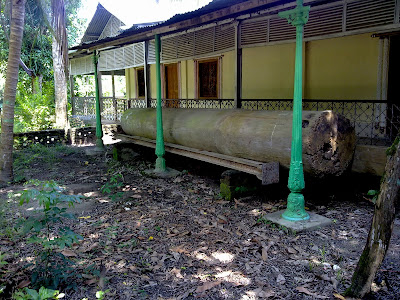Since my father's work has brought my parents to Jorhat, Assam for the past three years, I've made four visits to our home in Cinnamara, on the outskirts of Jorhat. And though Jorhat is more of a small industrial/educational hub and quite like any other town, there are places around it that have taught me much about the culture of the Assamese life.
Driving in and around Jorhat is such a pleasure.On either side of the road, as you dodge cows (the size of dogs), ducks, geese and chickens, you get an idea of how self-sustained and satisfied the people are in their environment. Everything in the country household, including the home itself is woven out of cane, which is an art that the average man out here is adept in. A little drawbridge will lead you inside a fence into a house with plantations and poultry and happy pigs. Postcard perfect.
Majuli is an island on the Brahmaputra, infact the largest river island in the world and is home to the Mishing tribe. We visited Majuli one summer afternoon during my vacations. The only way to get there is a ferry ride.
 |
| the brightly painted bow of the boats |
 |
| all aboard! (even cars) |
 |
the Brahmaputra. The most beautiful
river delta I've ever seen from an airplane. |
 |
If a boat should pass us by, this is the moment
when we all gasp and realize how unsafe and
overloaded these boats really are.
I saw beams almost giving way.
No kidding. |
 |
The dwelling of the Mishing tribe, traditionally, is a house
on stilts to prevent the home from being swept away
or getting waterlogged, by the Brahmaputra.
Wooden stilts are replaced by concrete posts
in modern structures. Often the house is
accompanied by a cattleshed on stilts = ) |
Though one is made to feel very welcome on this Island, there's very little to do, and as much as I'd have liked to sit and stare at the homes and lives of the tribals, it's a rather impolite thing. But thankfully, my parents had heard of the Mask makers of Majuli. There's very little heard/seen/written about this craft. I got really interested because last year we experimented with mask making techniques in college. I was fortunate to be invited to the workshop of Mr. Dharma Kanta Goswami, an elderly mask maker and artist from this island.
I wish I knew Assamese, that's the only language he speaks. Infact he hardly talks, he just shows you around the workshop with a grin that reaches his ears. And with such pride and passion that it'll make you feel like sitting down and taking a lesson. The masks and costumes he creates are for Bhavanas, traditional Assamese folk theatre that revolves around mythological themes such as stories of Krishna and the Ramayana. Here's some of Mr. Goswami's work:
 |
| a costume for Vishnu's avatar |
 |
a very large scale mask of a demon with a
mechanism that moves the jaw |
 |
| Garuda mask |
 |
| a book and incense stand in wood |
 |
| a mask portraying Sughreev from the Ramayana |
 |
| Here, one can see the cane framework |
 |
| Some of what goes into the mask |
 |
| The ferocious Narsimha mask, my favourite |
The making of a mask begins with a cane framework which is coated with cow dung and left to dry. It is then bandaged with papier mache or cloth and then dried in the sun. Then it is coated with a paste of very fine grey mud from the river bank and again, left to dry in the sun. Once it's dry, it's ready to be painted. (Takes about a week to make a mask). The technique followed is not very different from the Durga Puja idol makers. There were beautiful wall carvings, murals and pillars in Mr. Goswami's home. But these really caught my attention:
 |
| faces in the window grill |
 |
| a room on the roof with a spire |
 |
| drying kernels |
 |
| old doors |
The Satras, or Vaishnavite monasteries on Majuli are another part of the culture of the Island that lives on.
Most Satras have documented and preserved their rituals in small museums that display relics, garb, prayer instruments and tribal artifacts. Quaint, humble and informative. I wasn't sure whether to click pictures in the monastery, but I couldn't help taking a picture of this:
 |
This is,as they say, a stalk of a basil plant
that floated down the Brahmaputra and reached the monastery.
It measures atleast a meter thick in diameter.
Very hard to believe it's basil. |
If you chance to visit around the Bihu festivities, you will be able to catch a glimpse of the tribes in all their reverence for the culture. We were barely able to scratch the surface but I felt this visit was pretty insightful. Things out here are changing pretty fast.







Malavika, commendable observation in a short time. Glad to know that you liked what you'd seen. This is just a part of Assam, northeast India, which is so wrongly thought as a land of guns and wild beasts elsewhere in India. Know what, Majuli stills awaits the UNESCO recognition as a World Heritage Sight. Hope it gets it before it sinks completely.
ReplyDelete-- Kalyani.